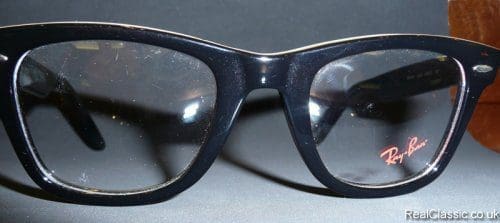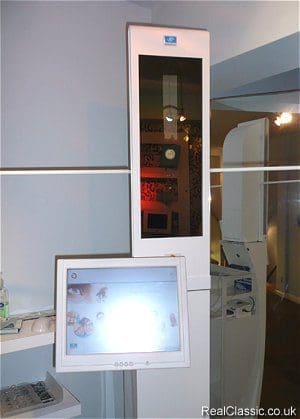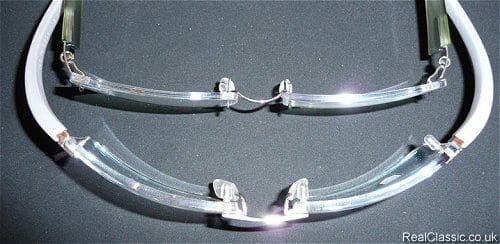All roads users need clear vision to drive or ride safely. Motorcyclists have to cope with visors and goggles, and classic riders frequently suffer from deteriorating vision, too. Paul Miles, RC’s resident professional eye expert, continues his explanation and delves into ordering spectacles…
…
To get the best effect from this professional advice, you really need to have read Part One, so go back and do it now if you haven’t already!
Darn it, I do need glasses, now do I get to spend my money, Doctor Paul?
So, the optometrist has demonstrated that you are able to see better with glasses than without and being sensible, you’ve decided to get something to improve your riding enjoyment. So, when you go to try on frames take your helmet with you. Most frames fit under a helmet, but not all and it’s important to find some that slide in unobtrusively and sit comfortably. Frames with thinner sides will generally offer a slightly less restrictive view than the more traditional heavy plastic Eric Morecambe type, although they offer fewer comedy opportunities, it must be said.

Most frames you will be shown are a variation on a theme, with the front of the frame either flat, or very slightly curved towards your eyes. This is OK for general use and, in fact, the image quality can deteriorate so quickly as you move your vision away from the centre of the lens it renders a lot of extremely large frames obsolete. This is actually an important issue. Rather like a long lens on a camera, if the middle is in focus, the edges will be slightly blurred. This is optics, I blame Newton, Joe Lucas is blameless this time.
It is demonstrable, however, that higher quality lenses have less peripheral distortion and wider fields of view than budget types, you really do ‘get what you pay for’. Taking that concept to its logical extreme, it’s even possible now to have totally bespoke lenses which offer a field of view 30% larger than even the best of the standard designs.
 |
Goggles on Right Now…… |
Using a fantastic bit of kit called the Visioffice you are electronically assessed wearing your chosen frame and hundreds of measurements are taken every second to determine if you are a head turner or an eye mover, and in what proportions, as of course, we are actually a little of each. The lenses are then ground individually with up to 1,200 changes of curvature per square millimetre (a budget lens has two over the whole surface, one on the front and one on the back).

The effect is astonishing. It’s almost like seeing the world in 3D again. Not cheap, but highly recommended.
Furthermore, it’s possible to have some spectacles made with very curved lenses that more closely follow the contour of your head. These designs, when fitted with appropriate lenses, increase your effective field of view, enabling you to see more. A good-ish analogy is a keyhole in a door, the closer you get to it, the more you see on the other side. You are somewhat limited in prescription for these, though, so ask your friendly optometrist about their suitability for you. The leading lights in this field are Tag Heuer, who have developed a range of driving spectacles for racing use, practical and cool!

Rimless frames are also very popular as they allow you to have a significantly larger lens area but still fit you correctly. Lens materials will either be glass or plastic. In reality, plastic is the only sensible option as they are virtually unbreakable (useful if the lens is struck by a stone) and much lighter in weight. It is possible to toughen glass lenses sufficiently, but they become even thicker and heavier than normal, so are only really suited to indoor use, such as the workshop.
Talking of plastic lenses, the stuff that springs to mind is Polycarbonate. It’s used in visors, after all. Polycarbonate is just one of dozens of resins used to make spectacle lenses and is the only one that’s 100% unbreakable. All of the others are pretty much as tough, though, and will cleave into large chunks if subjected to a massive wallop, unlike glass which splinters.
Plastics do have their downsides, the main issue being scratching. Most superior quality lenses are supplied with an anti-scratch coating, a type of baked on varnish. The very best coating we’ve ever used is the Crizal Forte Scotchguard from Essilor, which has a written unconditional guarantee against scratching for two years.
You should also specify an anti-reflection coating on your lenses. AR coats minimise the internal reflections in your lenses, increasing the transparency of the lens -the highly coloured reflections that make lead crystal vases so pretty are terrible news for corrective spectacle lenses. An uncoated lens only allows about 94% of the light to pass through it, while a fully coated lens will let more than 99.2% reach the eye and as a crisper image to boot. Cheap AR coatings are soft, though, and a pain to keep clean. The top of the range lenses will be anti-scratch, anti-reflection coated, hydrophobic (water runs off them without sticking or smearing) and oleophobic( an oily-repellent surface rendering them easy to clean, most useful for RealClassicists) all supplied as a package.
Again, boringly, you get what you pay for. Ask for a demonstration, if they can’t show you such a lens, go elsewhere.
——————-
Next Time: Paul gives advice on bifocals, tinted lenses, goggles and visors…


